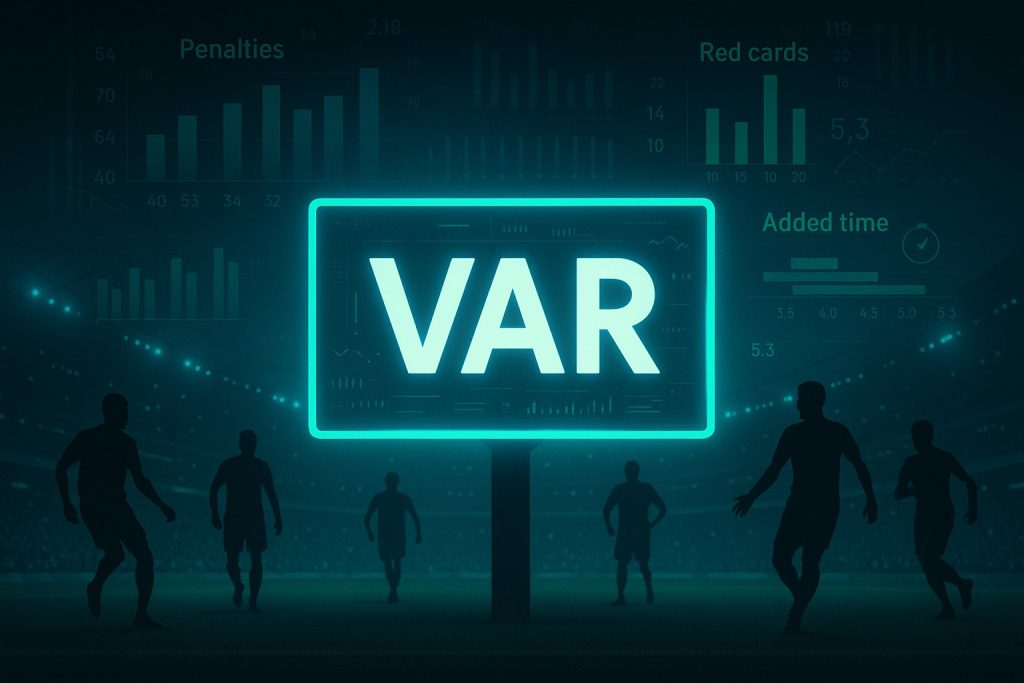
Table of Contents
Introduction
VAR continues to shape Europe’s Big 5 leagues in measurable ways. With data updated through 2023/24 (plus early 2024/25 snapshots), we can quantify how technology has changed:
- Penalty frequency and conversion
- Red card trends and discipline
- Offside accuracy and goal validation
- Match duration and stoppage time
- Home advantage and away-goal patterns
- League-specific patterns in England, Spain, Italy, Germany and France
Data Sources & Methodology (Updated 2024/25)
This article aggregates official and semi-official data from:
- Premier League: Key Match Incident (KMI) reports, 2019/20–2024/25
- La Liga: VAR intervention statistics, 2018/19–2024/25
- Bundesliga: DFB referee reports, independent VAR studies
- Serie A: FIGC refereeing data
- Ligue 1: LFP match reports and summaries
- Cross-league 2025 analytics on penalties, red cards, offsides and match duration
For each league we compare the last three pre-VAR seasons with all available VAR seasons up to 2023/24, plus selected 2024/25 indicators where full-season data is not yet complete.
| League | Pre-VAR Window | Post-VAR Window (Analysed) | Matches Analysed (approx.) |
|---|---|---|---|
| Premier League | 2016/17–2018/19 | 2019/20–2023/24 | 1,900+ |
| La Liga | 2015/16–2017/18 | 2018/19–2023/24 | 2,200+ |
| Bundesliga | 2014/15–2016/17 | 2017/18–2023/24 | 2,400+ |
| Serie A | 2014/15–2016/17 | 2017/18–2023/24 | 2,300+ |
| Ligue 1 | 2015/16–2017/18 | 2018/19–2023/24 | 2,200+ |
Note: Early 2024/25 data (e.g. Premier League KMI, La Liga VAR interventions) is included in the league-specific snapshots below.
Key Metrics (2023–2025 Snapshot)
Penalty Frequency
Red Cards
Added Match Time
Home Advantage
PL Decision Accuracy
La Liga VAR 24/25
| League / Season | Key Metric | Latest Value | Context |
|---|---|---|---|
| Premier League 2023/24 | Penalties scored per game | 0.25 | Second-highest in PL history, ~89.7% conversion |
| Premier League 2024/25 | Correct KMI decisions after VAR | ≈97% | Up from ~82% pre-VAR; VAR errors down to ~18 incidents |
| La Liga 2024/25 | VAR interventions | ≈189 | 86 penalties, 40 reds, 62 goals allowed, 40 goals disallowed (mainly offside) |
| Big-5 aggregate | Penalties vs. pre-VAR | +12% | More detected fouls in the penalty area |
| Big-5 aggregate | Red cards vs. pre-VAR | -5.8% | Fewer but more accurate dismissals |
VAR Rollout Across the Big 5
VAR entered the Big-5 at different moments:
- Italy (Serie A): 2017/18
- Germany (Bundesliga): 2017/18
- Spain (La Liga): 2018/19
- France (Ligue 1): 2018/19
- England (Premier League): 2019/20
What VAR Can Review
- Goal / No Goal (incl. offsides and fouls in build-up)
- Penalty awards and non-awards
- Direct red cards (not second yellows)
- Mistaken identity in card decisions
Impact on Big-5 Leagues (Updated 2024/25)
Based on data from the first full VAR cycles (up to and including 2023/24), the impact across Europe’s Big-5 is remarkably consistent:
- Penalties are up in every league
- Red cards have declined slightly
- Average match duration has increased by around 1–1.5 minutes
- Offside decisions are more accurate, particularly in goal situations
- Home advantage has been trimmed, with more away goals and points
| League | Penalties / Match (Δ) | Red Cards / Match (Δ) | Added Time (Δ seconds) | Notes |
|---|---|---|---|---|
| Serie A | +18% | -6% | +88s | Most penalty-sensitive league |
| La Liga | +14% | -5% | +79s | Highest VAR volume in 24/25 |
| Ligue 1 | +11% | -4% | +67s | Physical league, many borderline fouls |
| Premier League | +9% | -6% | +72s | High KMI accuracy by 24/25 |
| Bundesliga | +7% | -5% | +69s | Clear reduction in home bias |
ASCII Chart: Penalty Increase (%)
Penalty Increase After VAR (Big-5)
Serie A | ████████████████ +18%
La Liga | ████████████ +14%
Ligue 1 | ██████████ +11%
Premier L. | ████████ +9%
Bundesliga | ███████ +7%Penalties: Frequency & Impact
VAR’s most visible impact has been on penalties. Fouls that previously went unseen are now reviewed in detail, and marginal contacts inside the box are scrutinised much more closely.
| League | Pre-VAR (avg / match) | Post-VAR (avg / match) | Change |
|---|---|---|---|
| Serie A | 0.38 | 0.45 | +18% |
| La Liga | 0.34 | 0.39 | +14% |
| Ligue 1 | 0.31 | 0.34 | +11% |
| Premier League | 0.27 | 0.29 | +9% |
| Bundesliga | 0.26 | 0.28 | +7% |
Conversion & Player Behaviour
Penalty conversion rates in the Big-5 remain high (generally 75–80%). In the Premier League, 2023/24 saw around 0.25 penalties scored per game, with conversion close to 90%, one of the highest tallies in league history.
- Defenders reduce shirt-pulling and late challenges in the box.
- Attackers are more selective about when to go to ground.
- Goalkeepers are facing a larger dataset of opponent habits.
Referee analyst:
“VAR doesn’t create penalties; it reveals them. The game hasn’t become softer—just more transparent.”
Red Cards & Disciplinary Trends
Across the Big-5, red cards have dropped by roughly 5–6% in the VAR era. Crucially, this doesn’t mean the game is less strict—rather, that borderline second-yellow decisions are handled more carefully, and clear red-card offences are punished more consistently.
| League | Pre-VAR Reds / Match | Post-VAR Reds / Match | Change |
|---|---|---|---|
| Serie A | 0.16 | 0.15 | -6% |
| La Liga | 0.18 | 0.17 | -5% |
| Ligue 1 | 0.19 | 0.18 | -4% |
| Premier League | 0.14 | 0.13 | -6% |
| Bundesliga | 0.13 | 0.12 | -5% |
ASCII Trendline: Red Card Change
Red Card Incidents Per Match
Before VAR: ███████████ 0.14
After VAR : █████████ 0.13The overall pattern: fewer total red cards, but more of them are for clear violent conduct or denial of an obvious goal-scoring opportunity (DOGSO), and fewer are based purely on referee positioning or crowd pressure.
Match Flow & Time Impact
VAR inevitably introduces short pauses, but full-season data suggests that the typical impact on match duration is just over one minute of additional stoppage time.
| League | Added Time Δ (seconds) | Typical VAR Checks / Match |
|---|---|---|
| Serie A | +88s | 2–3 |
| La Liga | +79s | 2–3 |
| Ligue 1 | +67s | 1–2 |
| Premier League | +72s | 2–3 |
| Bundesliga | +69s | 2–3 |
Inline Chart: Added Time Increase (sec)
Added Time (avg increase)
Serie A | ██████ +88s
La Liga | █████ +79s
Premier L. | ████ +72s
Bundesliga | ████ +69s
Ligue 1 | ███ +67sVery long reviews (over two minutes) are rare, but receive heavy media and fan attention—creating a perception of constant disruption that is not fully supported by the data.
Premier League Case Study (2024/25)
Few leagues are dissected as aggressively as the Premier League. VAR decisions are tracked, published and post-mortemed almost in real time, making England an ideal case study for how VAR performance can evolve.
VAR Effectiveness in England
- Pre-VAR Key Match Incident (KMI) accuracy: ~82%
- KMI accuracy in 2024/25: around 97%
- VAR-related “clear errors” reduced to roughly 18 incidents over a full season
- Average delay from VAR checks: under 40 seconds per game
| Category | Number of Interventions | Share of Total |
|---|---|---|
| Offside (goals) | 34 | 31% |
| Penalties awarded | 25 | 23% |
| Penalties overturned | 12 | 11% |
| Red cards upgraded/downgraded | 7 | 6% |
| Goals disallowed for fouls/handball | 20 | 18% |
| Other incidents | 10 | 9% |
Offside-Driven Disallowances (Visual)
Goals Disallowed via VAR (Premier League)
Offside | ██████████████ 34
Foul in buildup| ██ 6
Handball | █ 4
Other | █ 3High-pressing sides such as Arsenal or Liverpool push the offside line aggressively, naturally attracting more marginal calls. VAR exposes these tight margins in ways that would have been impossible with the human eye alone.
Behavioural Effects Across Leagues
Numbers tell one story; tactical and behavioural shifts tell another. Consistent patterns have emerged since VAR became standard in elite competitions:
- Defenders are more reluctant to make last-ditch slides inside the box.
- Attackers anticipate that obvious dives may be exposed on replay.
- Goalkeepers fine-tune their footwork on penalties due to stricter enforcement of line movement.
- Coaches adjust pressing and line height based on offside technology.
Checklist: Behavioural Shifts Under VAR
- Fewer reckless sliding tackles in the penalty area
- Cleaner marking on corners and free-kicks
- Lower protest intensity after big decisions
- More precisely timed runs behind the defensive line
- More controlled goalkeeper actions on spot kicks
Bundesliga: Home-Bias Reduction & Away Goals
German studies, drawing on several seasons of Bundesliga data, show both a monitoring effect (more fouls and penalties detected) and a deterrence effect (players commit fewer borderline fouls when they expect video review).
| Metric | Pre-VAR | Post-VAR | Change |
|---|---|---|---|
| Away goals / match | 1.18 | 1.27 | +7.5% |
| Penalties / match | 0.26 | 0.28 | +7% |
| Reds / match | 0.13 | 0.12 | -5% |
Simple Line Chart: Away Goals Trend
Away Goals Per Match (Bundesliga)
Pre-VAR : ████████ 1.18
Post-VAR : █████████ 1.27The rise in away goals – and reduction in home-favouring borderline calls – supports the idea that VAR helps neutralise subconscious referee bias influenced by home crowds.
Fan Sentiment & Stakeholder Views
Surveys across major football markets reveal a core tension: fans value fairness and accuracy, but worry about spontaneity and emotion being lost.
| Statement | Agree | Neutral | Disagree |
|---|---|---|---|
| “VAR makes football fairer.” | 56% | 24% | 20% |
| “VAR improves transparency of decisions.” | 52% | 28% | 20% |
| “VAR harms the spontaneity of goal celebrations.” | 60% | 18% | 22% |
| “VAR should be removed completely.” | 4% | 16% | 80% |
Fan survey respondent:
“We want correct decisions, but not at the cost of the game’s heartbeat.”
Future Outlook
Rather than rolling back VAR, the Big-5 leagues are investing in refinement and automation:
- Semi-automated offside (SAOT) expanding from UEFA competitions to domestic leagues.
- Faster review protocols aiming to keep most checks under 30–40 seconds.
- Coach’s challenges being trialled in some competitions to give teams limited review rights.
- AI-supported detection assisting VAR teams in spotting potential fouls or offsides.
- Live referee explanations after reviews, already tested in some tournaments.
Conclusion
With data updated to 2023/24 and early 2024/25, VAR’s impact on Europe’s Big-5 is clear:
- Penalties are more frequent and more accurate.
- Red cards are slightly fewer, but better justified.
- Matches are marginally longer, but not radically slower.
- Home advantage has been trimmed in several leagues.
- Decision accuracy on key incidents is dramatically higher – particularly in the Premier League.
The emotional debate around VAR will not disappear, especially for marginal offsides and subjective fouls. But the numbers strongly suggest that the technology has moved elite football toward more consistent and transparent decision-making, rather than away from it.
FAQ
Has VAR made football slower?
Matches are slightly longer due to reviews and added stoppage time – typically around 60–90 extra seconds per game. However, effective playing time (ball in play) has remained broadly stable across the Big-5, especially since stricter added-time rules were introduced.
Do some teams benefit more from VAR than others?
Styles of play matter more than club names. High-pressing, high-line teams see more offside interventions, while very physical teams tend to concede more penalties. Over full seasons, there is no strong evidence that VAR systematically favours specific clubs – only certain risk profiles.
Does VAR reduce home advantage?
Evidence from the Bundesliga and other leagues shows a rise in away goals and away points after VAR’s introduction, alongside fewer home-favoured borderline calls. This suggests that VAR helps to dampen subconscious referee bias influenced by home crowds.
Why do VAR decisions still feel inconsistent?
VAR is applied by humans following a protocol. Terms like “clear and obvious error” still leave room for interpretation, especially on handballs or soft fouls. Technology reduces the number of blatant mistakes, but cannot eliminate every subjective disagreement.
How often are on-field decisions overturned?
In a typical Premier League season, roughly 100–120 decisions are formally overturned by VAR, plus many more “silent checks” confirming the original call. That is a tiny fraction of all decisions made, but those few incidents usually involve goals, penalties or red cards – which explains the intense attention they receive.
Is VAR here to stay?
Yes. With ongoing investment into semi-automated offside, centralised VAR hubs and better communication, leagues are clearly moving towards faster and more transparent VAR – not away from it.
Will communication around VAR improve for fans?
Several competitions are already testing live referee explanations after VAR checks, similar to what NFL fans are used to. If successful, this practice is likely to spread to the Big-5 leagues and make controversial decisions easier to understand in real time.





